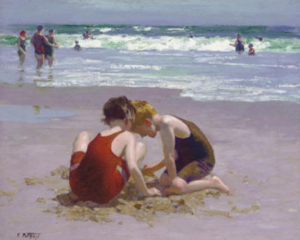If you asked a dealer in 19th and 20th century art to rate subjects in terms of popularity, he or she would undoubtedly put still life paintings of dead fish or game down at the bottom of the list (along with portraits) and put beach scenes at the top. Beach scenes have been enduringly popular with the general public, and no American artist illustrates this phenomenon better than Edward Henry Potthast (1857-1927).

Born in Cincinnati to a cabinet maker and his wife, Potthast showed early artistic interest and was studying at a local art school by the age of 12. By the time he was a young man, he was working as a lithographer in a local printing firm. Like many of his contemporaries from applied arts backgrounds, he would move easily between fine and commercial art for the rest of his life.
Potthast followed the example of many Midwestern artists of German ancestry and studied at the Royal Academy in Munich, where he absorbed the teachings of instructors steeped in the dark palette and bravura brushwork of the 17th century Old Masters. Only later would he study in Paris, where he picked up the bright tonalities of the Impressionists. He would divide his time between Cincinnati, earning money, and Europe for the next twenty years. In 1895 he moved to New York, which would be his artistic base for the rest of his life.
Potthast would be just another of the solid but relatively unknown American artists from the decades around the turn of the last century had he not, at around the age of 50, stumbled onto the subject that has kept him in the public eye ever since – beach scenes. He had painted peasant women, scenes of farm life, and landscapes galore, but with beach scenes, Potthast found a sure-fire winner. He may have been influenced by the example of the Spanish painter Joaquin Sorolla, whose 1909 exhibition at the Hispanic Society of America in New York was a sensation, attracting over 150,000 viewers who thrilled to Sorolla’s bravura beach scenes.
Whatever the influence, Potthast’s adoption of the beach scene as subject put him on the path to becoming one of the stars of American Impressionism. In the early 1980’s, when I began dealing, Potthast’s 12 x 16-inch beach scenes generally sold in the mid-five figures at auction. The rocket was about to take off – in the next ten years, they would double and triple those prices. The current record for a 12 x 16-inch beach scene at auction is $332,800, set in 2004, and larger works have sold for over a million dollars.
The market for American Impressionism has backed off a bit from its pre-Recession days for all but the finest examples. But there are still buyers in the six figures. A good Potthast 12 x 16-inch beach scene sold for $225,000 at auction this past May. (This market analysis applies only to the beach scenes. Not even a year ago, you could have bought a lovely still life of lilacs by Potthast for $10,000.)
With the works of any artist, when prices begin to rise significantly it becomes worthwhile for forgers to set to work, and I’ve seen my share of fake Potthasts. (The most egregious had a bather in a bikini. I had to point out to the owner that the bikini was not worn on American beaches in the 1920’s.) One of the first coffee table books on American Impressionism, by Donelson Hoopes, was published in 1972, and the Potthast beach scene that Hoopes reproduced in his book found its way, in multiple variations, into a number of fakes over the next ten years.
All of which is to say that it might be wise to give me a call if you’re considering adding a little sun, surf, and bathing dresses to your wall. Let’s talk.

